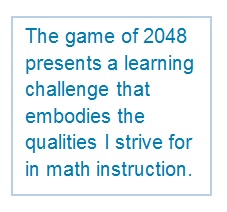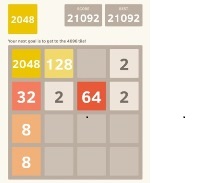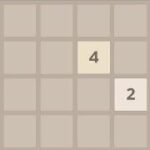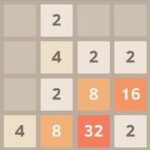The game of 2048 is a free app for iPhones and Android phones. When you begin a game, you see a 4-by-4 array of square tiles. A few tiles have numbers on them—always 2s and 4s—but most of the tiles are blank.
The goal of the game is to get a tile with the number 2048 on it. You play by sliding a finger up, down, or across a column or row on the game board. When you swipe so that two tiles with 2s on them touch, the two 2s disappear and are replaced with a 4 on one of the tiles. And if you swipe so that two 4s touch, you get an 8. Two 8s make a 16, two 16s make a 32, and so on. Doubling in this way, you can work your way up―2, 4, 8, 16, 32, 64, 128, 256, 512, 1024, and, finally, 2048. When the grid becomes completely full with numbers on all tiles and no two adjacent tiles have the same number, the game automatically ends.
I found the game easy to play but also vexing.
Two weeks after her first email, Sandra wrote in another message, “Made it!” And she attached a screenshot of her completed game showing the 2048 tile. (See the photo at the beginning of this post.) By the time I received Sandra’s victory message, the greatest number I had managed to produce was 512.
According to Wikipedia, after the game of 2048 was released in March of 2014, it received four million visitors in less than a week. I mentioned the game to my three grandchildren who live nearby. Two of them had been playing it on and off. “I figured you already knew about it since it’s a math game,” Charlotte, a tenth grader, told me. I confessed to them that I wasn’t having much success with getting past 512. Jeffrey, a fifth grader, was sympathetic. He told me, “I keep getting stuck when I can’t move the tiles to get the numbers that match next to each other so I can double them.”
The next week I talked with Charlotte again about the game. She told me that she was able to get a tile with 2048 on it fairly regularly. I asked for tips about how to swipe, and she gave me simple, clear, and effective advice, demonstrating on my phone. I followed her advice and now have gotten to 2048 several times.
Once you reach 2048, you have the option of continuing to play and trying to get to 4096 and beyond. I haven’t had any success with that. Yet.
So, how did the game of 2048 help me think more about teaching math and my ongoing quest to improve my classroom teaching practices? I think that playing 2048 is a learning challenge that embodies the qualities I strive for in math  instruction. The game presents a problem situation to investigate―to get to 2048. It’s accessible to a wide range of abilities―getting started is easy. It allows for differentiation―there are different levels and ways to engage. (And a 5-by-5 version of the game, 2048 Extreme—also available as a free app—makes it easier to be successful and was more fun for Jeffrey). The game encourages looking for regularity and structure―you strive to figure out how to make more effective swipes. It provides the opportunity to make and test conjectures―you have many opportunities to test your ideas about making more effective moves.
instruction. The game presents a problem situation to investigate―to get to 2048. It’s accessible to a wide range of abilities―getting started is easy. It allows for differentiation―there are different levels and ways to engage. (And a 5-by-5 version of the game, 2048 Extreme—also available as a free app—makes it easier to be successful and was more fun for Jeffrey). The game encourages looking for regularity and structure―you strive to figure out how to make more effective swipes. It provides the opportunity to make and test conjectures―you have many opportunities to test your ideas about making more effective moves.
The game of 2048 inspired me to solidify the qualities that I dream about for math lessons. I’m always on the search a classroom investigation that
- presents a problem situation to investigate;
- is accessible to a wide range of abilities;
- allows for differentiation;
- encourages looking for regularity and structure;
- provides the opportunity to make and test conjectures; and
- is appropriate both for individual exploration and group collaboration.
P.S. Friends have told me that the game of 2048 is based on the game of Threes, another to try. I haven’t yet. I don’t need one more addiction right now.
Classroom Suggestions
My granddaughter Charlotte made the assumption that I already knew about the game of 2048 because it was a math game. And while it’s true that the game involves numbers, it’s also mathematically interesting because it embodies important mathematical practices—making sense of a problem and persevering to solve it, and looking for and making use of structure. At first I didn’t think of the game for classroom instruction, but on reflecting I think it would be worthy as an investigation itself and also as a springboard for talking about the doubling pattern that leads to powers of two.
- Using the game of 2048 in the classroom is appropriate if all students have access to the app. If so, I suggest that they first have time to explore the game on their own and play the game at least ten times. Then ask pairs or small groups to share their ideas about the game in two categories:
What do we know so far?
What would we still like to know?
Ask them to write statements in both categories. To manage sharing of ideas with the entire class, either give them sentence strips that you can post or have them record on chart paper.




Can you share Charlotte’s advice?
The advice Charlotte gave me for playing the game of 2048 was to swipe down and to the right consistently, and to avoid swiping up or to the left. It’s not a guaranteed strategy but seems to have some merit.
Would this be appropriate for 5th graders?
Absolutely. But my fifth grade grandson was getting frustrated until I downloaded 2048 Extreme, which is a 5-by-5 grid (instead of a 4-by-4 grid) and he was able to be more successful. Good luck. Keep me posted.
One tip for playing the game with small children: don’t tell them that they are trying to get to 2048. If they don’t know that “winning” is the objective, then they have a greater chance of just experimenting and playing along the way. Both my 7 and 5 yr old love this game (and related games), even though they can rarely get beyond 256.
We recently had a good discussion comparing 2048 (powers of 2) to 2584 (Fibonacci sequence): here. I’m sure you will quickly see how well suited this game structure is for the Fibonacci sequence (or others with a similar recursion relationship, like the Padovan sequence).
Some other natural extension questions and explorations that come out of playing the game:
(1) what is the maximum tile value you could have on the 4×4 board?
(2) how would you score the game? how do you think the “official” game determines your score?
(3) how many swipes does it take to get a tile with a given value?
(4) obvious connections to powers of 2, logarithms, binary
(5) what could you change to make the game easier? harder?
(6) using either Scratch or Pencilcode, making their own version of the game and experimenting with variations is probably within the grasp of a beginning programming student. My direct experience is with 5th graders in their first year learning about programming and it is probably just beyond their ability right now.
This is my first year teaching Georgia math. There is a lesson that involves first graders measuring each other’s height and arm span. Once they have measured, they are to decide if they are a square, tall, or wide rectangle. This lesson is adapted from your “Are you a square?” I have no idea what this means. Can you please help?
Thank you,
Rachele Laperna
If a person’s height and arm span and the same length, then the person is a square. If a person’s height is longer than his or her arm span, the person is a tall rectangle. If a person’s height is shorter than his or her arm span, the person is a wide rectangle. Kind of silly, I know, but I’ve enjoyed doing this with students . . . and with adults. I hope this helps.